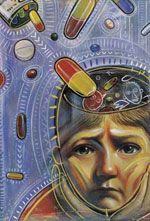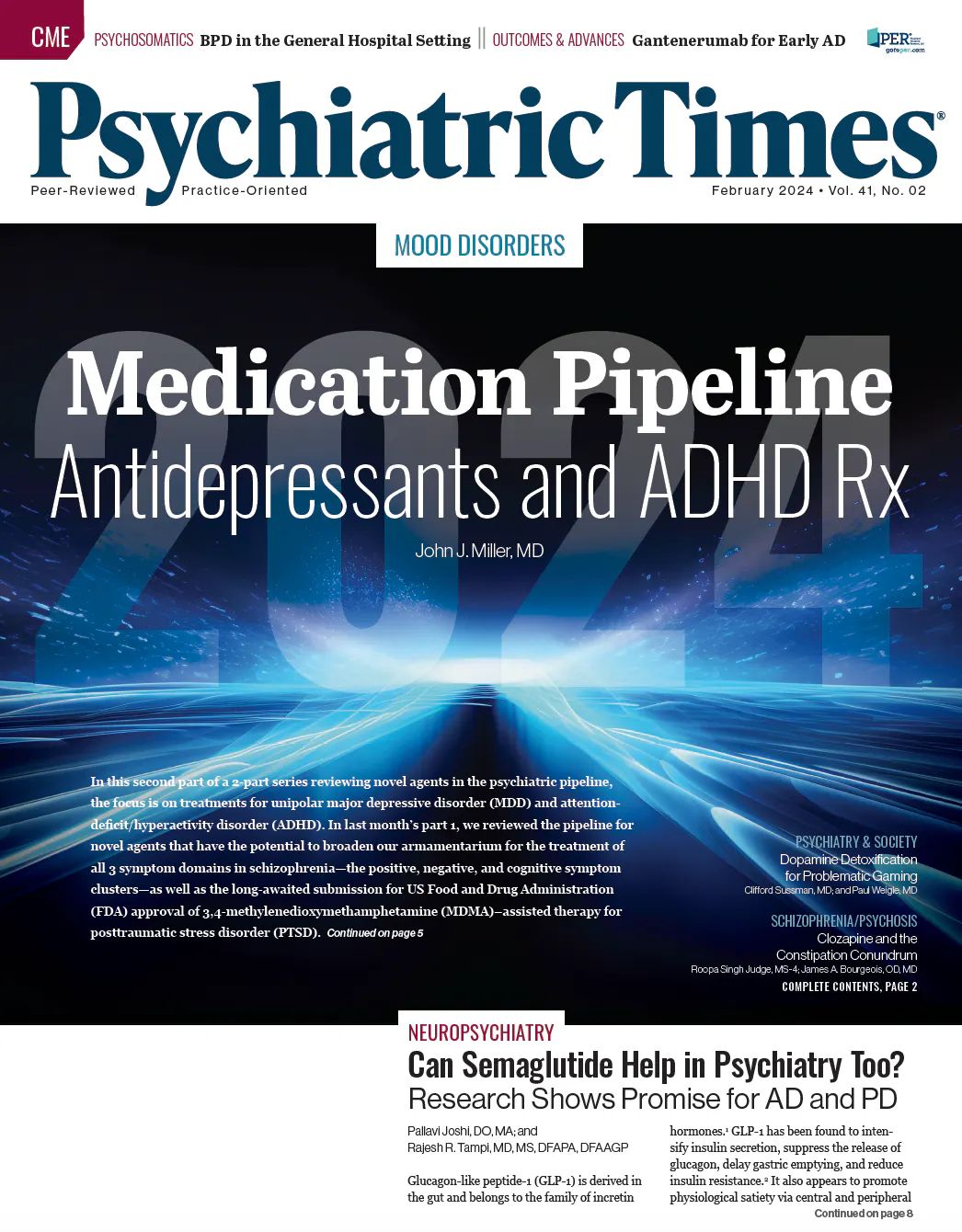Publication
Article
Psychiatric Times
Psychopharmacology for Medically Ill Patients
Author(s):
The prescription of psychotropic medications for patients with complex comorbid medical and psychiatric conditions is a cornerstone of psychosomatic medicine (PM) practice.

The prescription of psychotropic medications for patients with complex comorbid medical and psychiatric conditions is a cornerstone of psychosomatic medicine (PM) practice. Nearly three-fourths of patients seen in psychiatric consultation in the general hospital receive psychotropic medication to treat a broad range of psychiatric diagnoses, including depression, anxiety, delirium, dementia with behavioral disturbances, and substance dependence and withdrawal.1 The most frequently prescribed psychotropics are antidepressants and atypical antipsychotics, followed by benzodiazepines and then mood stabilizers, particularly antiepileptics.
Overall, PM psychiatrists (who represent a small subspecialty within psychiatry) account for a small fraction of psychotropic prescribing for the medically ill. Most psychotropic prescriptions are written by primary care physicians (49%), psychiatrists (33%), and other medical specialists (18%).2 General psychiatrists are increasingly aware of medical comorbidity in their patients and feel the need to treat their patients through acute and chronic medical illness. However, while the prescription of psychotropics for patients with medical illness is highly relevant across medical specialties, physicians outside the field of PM often feel ill-equipped to prescribe for such patients because they are unfamiliar with the growing evidence base and are concerned about issues of safety, effectiveness, and drug-disease and drug-drug interactions.
The Table outlines some of the major issues that must be considered in prescribing psychotropics for patients with medical and psychiatric comorbidity.
Making a treatment decision
Before prescribing psychotropics for the medically ill, differential diagnosis is key, because this will influence not only the choice of psychotropic agent but also expectations about treatment response and possible adverse effects. In a patient with stage 4 colon cancer, is the combination of low mood, amotivation, psychomotor retardation, lack of energy, and poor concentration due to depression, delirium, cancer, or some combination? Are these symptoms be-ing produced in part by chemotherapy, corticosteroids, pain medications, other factors? In making a diagnosis and prescribing treatment, use clinical judgment in the interaction with the patient and consider personal and family psychiatric history, collateral history (often the only history that is reliable), and knowledge of the medical condition and its treatment.
The question of effectiveness of psychotropic medications for patients with comorbid medical and psychiatric conditions is an interesting one. Until recently, there were limited data on the efficacy of psychotropics in patients with comorbid medical illness. It is well known that the vast majority of mainstream psychopharmacology efficacy studies, on which government regulatory approval is based, exclude medically ill patients.
In the case of depression, early, uncontrolled evidence concerning the efficacy of antidepressants in the medically ill was not encouraging. Fortunately, over the past 10 to 15 years, with growth of the PM subspecialty, there is an increasing number of randomized placebo-controlled trials that document the efficacy and safety of psychotropics in conditions such as cardiovascular disease, stroke, cancer, and HIV/AIDS for comorbid psychiatric disorders, including depression, anxiety, and delirium as well as troublesome quality-of-life symptoms such as fatigue, pain, and cognitive problems.
Perhaps the most well-known study in this area is the randomized, placebo-controlled, multisite Sertraline Antidepressant Heart Attack Randomized Trial (SADHART), in which sertraline at standard dosages was shown to be safe and efficacious for depression after myocardial infarction.3 In many ways, this study not only contributed to the evidence base but also raised hope about the treatment of complex comorbid conditions and spurred motivation to continue high-quality PM-psychopharmacology research.
TABLE:
Considerations in psychotropic prescribing for the medically ill
• Are psychiatric symptoms caused or exacerbated by the medical illness?
• Are there neuropsychiatric adverse effects of medications used to treat the comorbid medical condition?
• Is there evidence of efficacy for psychotropics for this medical/psychiatric presentation?
• Is there likely to be a drug-disease interaction?
• Will the psychotropic drug exacerbate, improve, and/or affect the course of the medical illness?
• Will the medical illness affect the pharmacokinetics of the psychotropic medication?
• Does medical illness cause vulnerability to psychotropic adverse effects, particularly CNS effects?
• Is there likely to be a drug-drug interaction?
Drug-disease interactions
Once the decision to prescribe a drug for a medically ill patient is made, psychotropic drug-disease interactions are an important consideration. These interactions can be both deleterious and favorable. The potential for deleterious interactions may contribute to the undertreatment of psychiatric problems in the medically ill and cause further morbidity. For instance, the clinician may hesitate to prescribe an antipsychotic drug for a diabetic patient with postoperative delirium for fear it might worsen glycemic control. In this instance, the temporary risk of exacerbating diabetes must be weighed against the substantial lasting risk of untreated delirium, which itself creates distress for the patient and the family and increases the length of hospital stay, morbidity, and mortality.
With proper awareness of the risks, careful selection of psychotropic agents less likely to exacerbate medical issues, better information about available drugs, collaboration with medical colleagues, and treatment monitoring, the vast mojority of patients with medical and psychiatric comorbidities can be successfully treated.
Psychotropic drug-disease interactions can also be favorable. There is substantial evidence that psychotropics may ameliorate symptoms such as pain, nausea, and fatigue and may improve the course of medical illness via enhanced treatment adherence and biological mechanisms.
Drug-drug interactions
Another major concern is that the medical disease state may affect the metabolism and elimination of psychotropic medications. This concern is most evident for patients with liver and renal disease, but may also be substantial for patients with GI disorders that affect absorption and for patients with cardiopulmonary disease. While a review of this topic is well beyond the scope of this article, exhaustive reviews exist and the medical literature and medication product information help guide medication choice and dosing in various disease conditions.4 Psychotropic medication dosing strategies can be found for most medical conditions.
The issue that often creates the greatest degree of trepidation in prescribing psychotropic agents for patients with medical comorbidity is the potential for drug-drug interactions. In many ways, psychiatrists are well prepared for this issue because there are multiple examples of interactions between psychotropic medications themselves. Drug-drug interactions can result in increased serum levels of one or both coadministered drugs, with a consequent increase in drug toxicity.
Drug-drug interactions can also cause a decrease in the serum level of 1 or more of the coadministered drugs and can lead to lack or loss of efficacy, for either the psychiatric or medical condition. Some interactions result from the pharmacodynamic effects (or receptor affinities) of drugs that lead to additive or antagonistic effects. Others are a result of pharmacokinetic alterations (either inhibition or induction) produced by a drug on the metabolic pathway of another, or alterations in protein binding.
Drug metabolism is most often accomplished via the cytochrome P-450 system in conjunction with the UDP-glucuronosyltransferases. These systems can be extensively affected by psychotropic drugs. Inhibition of other systems, such as P-glycoprotein efflux transporters and the organic anion transporting polypeptides, may be significant, but they are less studied.
The combinations and permutations of potential drug interactions are staggering, and no individual could possibly commit them to memory. Furthermore, when considering drug-drug interactions, clinicians must take into account not only prescribed medications but also over-the-counter medications, supplements, and complementary/alternative agents that the patient is taking. Fortunately, multiple tools exist to assist the clinician in anticipating and identifying potential interactions; thus, it is necessary to only understand the potential mechanisms for the interactions, to check before prescribing, and to observe closely while patients are receiving treatment.5,6 Therapeutic drug monitor-ing can be useful in this regard; however, it is available for a limited number of medications.
Prescribing psychotropic medications for patients with medical illness is an important part of PM practice, but it is not limited to PM practice and increasingly will be encountered by the general psychiatrist. Our evidence base for psychotropic safety and efficacy is mounting, and awareness of a few key principles ensures that practitioners feel more comfortable prescribing and patients receive the treatment that they need.
References:
References
1. Schellhorn SE, Barnhill JW, Raiteri V, et al. A comparison of psychiatric consultation between geriatric and non-geriatric medical inpatients. Int J Geriatr Psychiatry. 2009;24:1054-1061.
2. Pincus HA, Tanielian TL, Marcus SC, et al. Prescribing trends in psychotropic medications: primary care, psychiatry, and other medical specialties. JAMA. 1998;279:526-531.
3. Glassman AH, O’Connor CM, Califf RM, et al; Sertraline Antidepressant Heart Attack Randomized Trial (SADHEART) Group. Sertraline treatment of major depression in patients with acute MI or unstable angina [published correction appears in JAMA. 2002;288:1720]. JAMA. 2002;288:701-709.
4. Ferrando SJ, Levenson JL, Owen JA, eds. Clinical Manual of Psychopharmacology in the Medically Ill. Arlington, VA: American Psychiatric Publishing; 2010.
5. Medscape Reference: Drugs, Diseases, & Procedures. Drug Interaction Checker.http://reference.medscape.com/drug-interactionchecker. Accessed October 7, 2011.
6. University of California, San Francisco. Database of Antiretroviral Drug Interactions. http://hivinsite.ucsf.edu/insite?page=ar-00-02. Accessed October 7, 2011.




